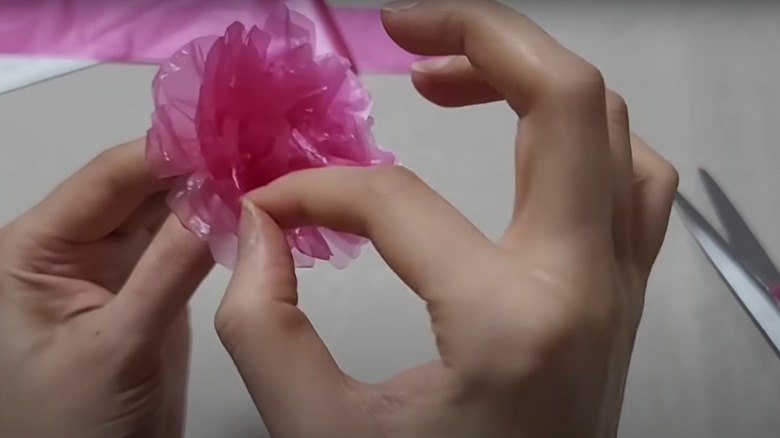13 Unexpected Ways To Repurpose Bread Bags In Your Home & Garden
Let's break some bread and talk about the bags they come in. Bags do their job by locking in moisture to keep bread fresh. But, do the math. According to History of Bread, the average American eats 53 pounds of bread a year. That amounts to quite a few bread bags going to waste in the typical American household!
Before you price out a bread machine to avoid such wastefulness, you might find a crumb of comfort in knowing that there are quite a few useful ways to reuse the bags. If you want to start upcycling, though, make sure to employ this genius hack that neatly stores plastic bags with one common household item, an empty tissue box. You can also turn to a simple cabinet organization tip that makes storing plastic bags so convenient with peel-and-stick hooks. For all of these projects, you'll need to learn how to clean and disinfect plastic bags so you can reuse them around the house and garden. But no matter what you need, you can probably recycle your bread bags in order to create it.
1. Make a blanket
You can cut bread bags into strips and turn it into plarn (a portmanteau of plastic and yarn) to knit and crochet blankets. With a flattened-out bag and after a series of cuts with sharp scissors, the plastic will be turned into one long strand ready to be crafted. Fiber artists combine bags for color, and their creations often turn out looking like scrap blankets. There's also a method for weaving the material without hooks and needles, which works particularly well for sleeping and camping mats.
2. Turn into liners
This bread bag hack will work with small garbage bins such as those in offices under cabinets and desks, in bathrooms for trash such as facial tissues and empty toothpaste tubes, or in the kitchen for food scraps. Open the bread bag and lift it over the rim of the can. While the bags will still eventually end up in the landfill, you'll save money on new liners and force an extra use out of single-use plastic. Some have adapted this repurpose in cars too, using the bags for discarded straw wrappers, empty pup cups, and stray Cheerios.
3. Reuse in the refrigerator
Bread bags can be utilized to store food such as pastries and soup in the freezer. This is a great trick if you prepare food ahead for the week, particularly if you're on a special diet requiring portion control, or you head a busy household where your job makes preparing meals from scratch each night next to impossible. It also makes easy work of storing food prepared in advance for holidays or preserving in-season vegetables that can be enjoyed later in the year. In the refrigerator, it's also an old standby for storing a block of cheese.
4. Fashion into ice packs
You come home from the chiropractor and have to care for your back. Your child skins a knee. You want to bring down puffiness around morning eyes. Forget about bags of frozen peas and use plastic bread bags to create ice packs instead. If you have an ice maker or ice trays, this reuse is super easy. Otherwise, fill the bags with water and place gingerly in the freezer. But make sure to tie the bags tightly so that there is no leakage. You'll have first aid at the ready for almost any moment in need.
5. Care for plants
Bread bags are great for turning into humidity domes for propagation and seedlings, just mist the garden starter and place the bag over the pot. The same approach applies for indoor plants while you're away. Slide a bag over the plant so that it retains moisture (and won't suffer during an extended period without watering). Plastic bags can also be used as planters, but once the plant has grown to a certain size, you'll want to rehome it to a traditional pot. This is a technique some use for growing vegetables such as carrots and turnips in particular.
6. Create gift bags
While gift cards are a favorite go-to for teacher gifts, some prefer to show appreciation employing the human hand by making or shopping for something. You can bestow these presents in purchased gift bags, or get creative (and eco-friendly) by turning bread bags into gift bags. Nail polish remover will take away labels on the outside of the bag, but you might need to scrub hard with a sponge. Snip the top of the bag once closed to remove logos and other remnants of the bread bag's past. Tie the top closed with a ribbon.
7. Substitute for waste disposal
Of course you can buy scented poop bags in fancy colors, some of which are biodegradable, or hire someone, as folks with big dogs sometimes do, to clean the backyard. Instead, you can also save all that money by using bread bags to clean up after your dog, another way to get more use out of single-use plastic. This is also a great hack for those with cats, since bread bags are a solid way to dispose of smelly kitty litter. Job done (just, as always, pinch your nose while scooping).
8. Store other foods
This is another easy alternative for throwing out bread bags. Just get more life out of them by storing other eats. This works well for sending sandwiches and snacks to work or school, as well as containing baked-at-home breads. It's also terrific for extending the life of store-bought cookies. Resealing cookie packages can sometimes be difficult, and, once a sleeve of cookies is gone, the package takes up unnecessary space. To keep cookies fresh longer and take up less room in kitchen cabinets, store the sleeves in bread bags.
9. Reimagine as coasters
If you have bread bags (or any other supply of disposable plastic bags), consider how they can become custom coasters. Start the project as you would if you were going to knit or crochet the bread bags, creating strands of plarn. For coasters, braiding the plarn works nicely. Work the braided strands into circles to create the coasters, and glue over with a material such as Mod Podge to help keep the components together. Speed up the drying process by securing the woven loops fabricating the coasters with laundry clips.
10. Decorate a cake
Bread bags, in fact any plastic bags, can be turned into icing piping bags. You might only save a few dollars, but imagine the pride you'll feel for your resourcefulness. There are several methods for folding the bags, including rolling up one half first and securing with tape to prevent buttercream or other ingredients from escaping to the unused side. Most tutorials will recommend placing tape at the corner of the bag that you'll snip to create the hole to reinforce the area so it's easier to work with.
11. Repurpose into home decor
Place this reuse into the aspirational category because it will require time, effort, and resources (whether you try this on your own or if you want to buy products made from bread bags). On TikTok, @resourcefullivingau shows off an artistic tabletop crafted out of bread bags. On YouTube, @OneArmyVideos, which seeks to "create projects tackling global problems," turns bread bags (and many other types of bags) into a material that ends up looking like marble that can then be used to make bookends, knickknacks, cheese boards, and other objects for the home.
12. Fabricate flowers
With an iron, scissors, and some wire, you can turn bread bags into faux flowers, making this an environmentally conscious craft project that would be excellent for children. This creator offers an easy-to-follow visual YouTube tutorial using pink and green supermarket bags to make the flowers, but any bags can be used for this project, which is simple to do as long as you have patience with folding and cutting. Iron the bags flat under a sheet of paper first, and turn them into shapes that are transformed into leaves and petals. Metal wire is affixed with hot glue to keep the blossoms blooming.
13. Transform into an apron
Like any plastic bags, bread bags can be easily transformed into fabric. In her two-minute video, @UpcycleDesignLab shows how by cutting bags into sheets, layering them, then ironing. She also shows how to use plastic scraps to create patterns, which are then ironed along with the sheets. The fabric can be turned into a host of things or be used to cover whatever you like. She models an apron in the video that looks like a pumpkin, and she also shows off a trio of flower pots covered in the decorative fabric, demonstrating how flexible this material can be.

